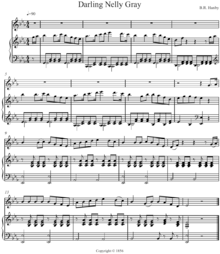Passamezzo moderno
The Gregory Walker or passamezzo moderno ("modern half step"; also quadran, quadrant, or quadro pavan) was "one of the most popular harmonic formulae in the Renaissance period, divid[ing] into two complementary strains thus:"
| 1) | I | IV | I | V |
| 2) | I | IV | I–V | I |
- (Middleton 1990, 117).
For example, in C major the progression is as follows:
C F C G C F C–G C
The progression or ground bass, the major mode variation of the passamezzo antico, originated in Italian and French dance music during the first half of the 16th century, where it was often used with a contrasting progression or section known as ripresi. Though one of Thomas Morley's characters in Plaine and Easie Introduction to Practicall Musicke denigrates the Gregory Walker, comparing unskilled singing to its sound (Morley 1597, 120), it was popular in both pop/popular/folk and classical musics through 1700. Its popularity was revived in the mid 19th century, and the American variant (below) evolved into the twelve bar blues (van der Merwe 1989, 198–201).
Examples

Listed in van der Merwe (1989, 198–201):
- several in The Fitzwilliam Virginal Book
- "Up and Ware Them A Willie"
- "Jimmie Rose"
- "Darling Nelly Gray"

- "Wreck of the Old 97"
- Woody Guthrie's "There is a House in This Old Town"
- Irving Berlin's "Alexander's Ragtime Band"
- The Rolling Stones' "Honky Tonk Woman" (1969)
- Carole King's "You've Got a Friend" (1971)
Listed in Helms, Ilmbrecht, and Dieckelmann (1954, ):
- Hans Neusidler's "Gassenhauer" (Nuremberg, 1536)
- "Oxstedter Mühle" (folk dance from Lower Saxony) (B section)
- Diego Ortiz' Recercada Prima / Segunda / Tercera sobre el Passamezzo Moderno (three-part didactic composition in Tratado de Glosas sobre cláusulas y Otros Generos de Puntos en la Música de Violones, 1553). (Readers of Spanish may benefit from the Spanish-language Wikipedia's more extensive treatment of Diego Ortiz and of the Tratado de Glosas.)
Others:
- Iron & Wine's "A History of Lovers" (Iron e Wine 2005, ) (verses; chorus and interludes follow ripresi IV–I–IV–V progression)
American Gregory Walker
The American Gregory Walker, popular in parlour music, is a variation in which the subdominant (IV) chords become the progression IV–I (van der Merwe 1989, 201–202).
1) I IV–I I V 2) I IV–I I–V I - (Middleton 1990, 117).
For example, in C major this variation is as follows:
C F–C C G C F–C C–G C
Examples
Listed in van der Merwe (1989, 201–202):
- "Jesse James"
- "The Titanic"
- "My Little Old Sod Shanty"
- "Cottonfields"
- Gus Cannon's "Walk Right In" (1929)
Other variations
On original progression
- Second strain's first I becomes I–I7 (for a stronger "lead-in" to the upcoming IV):
- "Gathering Flowers From the Hillside" (Carter Family 1935)
- Second strain progresses from IV directly to a full measure of V, displacing its second (half-measure) I:
- "Kiss The Girl" (Alan Menken and Howard Ashman, 1989) from Disney's The Little Mermaid (chorus; verses follow standard twelve-bar pattern)
- "Three Little Speckled Frogs" (traditional children's song)
- Bluegrass variation: First strain's change from I to IV and back is omitted:
- "She'll Be Comin' 'Round the Mountain" (traditional) text at Anon [n.d.]; melody at http://www.ingeb.org/songs/cominrou.mid (file composed specifically for dissemination via ingeb.org website pursuant to site's policy imposing non-commercial and share-alike restrictions but not attribution requirement)
- The Bluegrass variation frequently occurs in conjunction with the I–I7 "lead-in" and/or the direct IV-to-V transition listed above.
The resulting progression is ||| I | I | I | V || I(–I7) | IV | (I–)V | I ||| ; examples include:- "Free Little Bird" (David Holt and Doc and Merle Watson; not to be confused with Lynyrd Skynyrd's "Free Bird") (Holt, Watson, and Watson 2009).
- "Yakety Sax" (The Benny Hill Show theme) by Boots Randolph and James Q. "Spider" Rich
- "Mbube" (Solomon Linda, 1939), imported into English as "Wimoweh [uyimbube]"/"The Lion Sleeps Tonight"
On American variant
- IV–I is reversed, becoming I–IV or I7–IV:
- "Tennessee Waltz" (Stewart and King 1947) (verse and second strain of chorus)
- Second I in second strain becomes II7, yielding second-strain progression of || I | IV–II7 | I–V | I ||| :
- "Truck Drivin' Song" ("Weird Al" Yankovic, released 1999) (A section; also shifts rhythm of two final bars from | I–V | I ||| to | I | V–I ||| )
Notes
- ↑ Caution: Keeping all chords in root position produces parallel fifths (see parallel harmony), which are prohibited by classical (rather than popular) voice-leading rules. The following files may or may not be more suitable for use in strict counterpoint:



References
- Anon. n.d. “Coming 'round the Mountain”. Song text, at Leader in Lieder mit Midi Melodies website (accessed 22 May 2010)/
- Carter Family. 1935. "Gathering Flowers From The Hillside". Columbia 37636. Recorded May 7, 1935.
- Helms, Anna, Otto Ilmbrecht, and Heinrich Dieckelmann (1954). Die Tanzkette, Frankfurt am Main: Hoffmeister Verlag.
- Holt, David, Doc Watson, and Merle Watson. 2009. "Free Little Bird". Piney Grove Ramblers: Bluegrass for the People website (accessed 22 May 2010)/
- Iron e Wine [2005]. A History of Lovers CifrasFX website (accessed 22 May 2010).
- Middleton, Richard. 1990. Studying Popular Music. Milton Keynes and Philadelphia: Open University Press. ISBN 0-335-15276-7 (cloth); ISBN 0-335-15275-9 (pbk). Reprinted 2002.
- Morley, Thomas. 1597. A Plaine and Easie Introduction to Practicall Musicke. London: Peter Short.
- van der Merwe, Peter. 1989. Origins of the Popular Style: The Antecedents of Twentieth-Century Popular Music. Oxford: Clarendon Press. ISBN 0-19-316121-4.